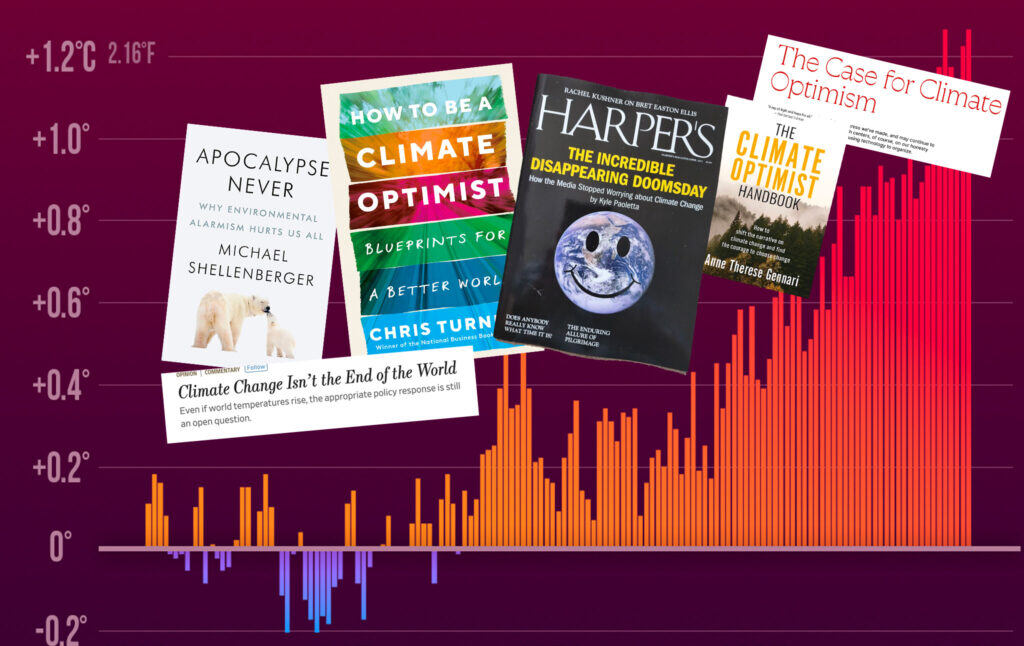
‘Climate Optimism’ Is Dangerous and Irrational
Overly-confident math models based on unrealistic assumptions are used to avoid crisis-consistent climate policies and to protect global elite privilege, while abandoning our duties to the planet’s most vulnerable.
In May of 2020, early in the COVID-19 pandemic, a White House economist used what is called a “curve-fitting” model to predict that COVID deaths would end within ten days:

That prediction turned out to be off by at least a million more American deaths and counting (at a rate of about 250 per day, or a daily plane crash).
Data-savvy media mocked this “absurd and dangerous chart” as “amateur hour.” Cathy O’Neil, author of Weapons of Math Destruction commented on the Trump White House model by writing that such “curve-fitting models have generated some spectacularly stupid projections.” But this kind of math-model myopia is not limited to Trumpian economists. As we’ll see, the climate crisis forecasts of the Intergovernmental Panel on Climate Change (IPCC) are just as dubious and delusional. At their worst, these predictions offer false comfort, fueling a “climate optimism” that amounts to the same kind of speculation as the confident White House prediction that COVID would be over and done with in a matter of days. The vast bulk of IPCC-curated models are similarly dodgy fantasies. They cook the books (and will cook the biosphere) by relying on unrealistic levels of fairy-tale technology and by ignoring many known salient factors.
“Since It’s Math, It Must Be Correct”
Nerds can be dangerous, because creating sophisticated mathematical prediction models can easily give the illusion of confidence about how things are going to go. And while we might expect the general public to misunderstand models, deference to bad models is common even at the highest levels of leadership, policymaking, science, and the media. Too often, performances of what we might call “nerd acrobatics” are used to conceal terrifying truths and immensely immoral priorities
It’s easy (and common) to give math models far too much credence. In a law review article called “Misunderstanding Models in Environmental and Public Health Regulation” Wendy E. Wagner, Elizabeth Fisher, and Pasky Pascual describe a “pervasive misperception of models as truth machines.” They write that “Computational models are highly contingent mathematical approximations of what reality might be like, yet in policy and legal circles they are often viewed as tools that are capable of providing precise, definitive answers.” They detect “multi-layered problems that result from this misunderstanding,” including a posture of “nearly complete deference to models,” enabled by a prevailing mindset that “since the model is mathematical, it is correct.”
To counter the “tenuous assumption that rational, technocratic analysis, including the false precision in models, can guide policy,” they recommend clearly explaining the limits of models to all decision makers involved. And, as they correctly note, “Without robust descriptions of key assumptions, uncertainties, and even the framing of a model, policymakers will not be able to rise above the core misunderstandings.” Wagner and her coauthors flag that models always involve “judgments that are not just scientific,” and importantly “model legitimacy is not a neutral issue but instead is inherently normative.”Modeling is no neutral numbers game: “examples abound of agencies perpetuating the misunderstanding of models as answer machines, while at the same time secretly cramming contested, value-laden assumptions [in] … behind the scenes.” Thus we should be wary of wonks claiming they’re just following “the numbers.”
Astutely, Wagner and her co-writers ask why these nerds don’t simply “overthrow policymakers’ misconception of models as truth machines.” Well, perverse incentives are at play: model-makers are “in the difficult position of either disappointing policymakers… [and risking] future funding.” This creates conditions for a dysfunctional dance of dishonest nerdery—rewarding what we might call the “truth-machine ruse.” Experts (and institutions) can gain by overselling their work or obfuscating math-model limits. We need far more realism in how models are sold to policymakers and the public alike.
Models have their place. Predictive models work well in many areas of physics, where well-understood, gravity-like laws govern, and it all does boil down to a handful of variables, which are causally connected by known and well-behaved equations. But physics-style machinery isn’t nearly so reliable in, say, social or economic systems—these don’t feature known and immutable fabric-of-the-cosmos-level laws, and their parts (e.g., people) often lack stable, mechanically predictable reactions.
Erica Thompson, in Escape From Model Land, shows how the concept of “Model Land” can make us savvier about the reliability, and limits, of modeling. Model land is a wondrous imaginary mathematical realm where all your assumptions are 100 percent correct, your equations accurately capture all the relevant moving parts, and nothing escapes your nerd superpowers. Thompson seconds Wagner and co.’s negation of neutrality claims: “models are unavoidably entangled with ethics, politics, and social values,” and the rarely revealed or discussed “social and political content of models is at least as important as” the math. But overusing this delusional mental “nerdvana” can have ruinous real-world ramifications, such as during the 2008 financial crisis, when supposedly risk-reducing math models risked wrecking entire economies. That’s why to understand our own world, we have to escape from “model land.”
The IPCC’s Official Modeling Malarkey
The scale of sheer malarkey in the models curated by the IPCC is earth-shattering. But first, let’s be clear: the IPCC does lots of valuable non-modelling work (like distilling tens of thousands of scientific papers into footnote-laden reports, albeit reports that few read, and that have little impact on policy). While they don’t make the models themselves, they do set the terms for the teams that do (which are almost entirely from rich nations, see Fig 1 here). The IPCC effectively curates which models are deemed “policy relevant.” Thankfully, if belatedly, certain carefully cherry-picked deficiencies are now getting media coverage. The fact that many other known flaws aren’t, though, has helped the media preach an unwarranted and dangerous “climate optimism.” 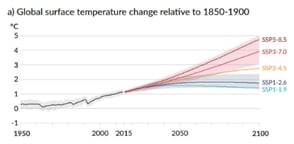
The main modeling problem now getting media attention has to do with an extremely high-emissions scenario known as RCP8.5. (RCP is an acronym for Representative Concentration Pathway and 8.5 refers to “radiative forcing,” which reflects earth-system heating effects of an additional 8.5 watts per square meter. If you need more, here’s a detailed explainer by CarbonBrief.org.) RCP8.5 has become one of the “most commonly used RCP scenarios” in the climate modeling community. But RCP8.5 has been criticized for its unrealistic assumptions, like that vast amounts of coal would continue to be burned for the rest of the 21st century. That colossal coal binge (RCP8.5 assumes a “six-fold growth in global coal consumption per capita”) is now looking quite unlikely, since solar and wind are now typically cheaper than coal.1
But kiboshing this “coal bender” assumption has led some to the view that climate change is no longer “apocalyptic” (and therefore, that those pushing for radical policy and behavioral crisis-level responses, like curtailments in global elites’ consumption, are irrational doomsayers). David Wallace-Wells of the New York Times, who famously wrote an alarm-raising book called The Uninhabitable Earth, more recently wrote that “existential fears about apocalyptic futures” (the 4ºC to 5ºC of RCP8.5’s top red line) have been reduced to warming in “a two-to-three-degree range” (the blue and orange lines). And so we read in a recent Harper’s cover story that “The age of climate optimism [is] upon us.” This mostly good-news sermon delivered by Kyle Paoletta ran under the headline “The Incredible Disappearing Doomsday.” Paoletta does say in the article’s actual text that “stories that give readers the misleading impression that things will be just fine are overcorrecting for our prior fatalism, and risk replacing it with complacency.” He adds that “it is, I promise, not quite as bad as you once imagined, but it is worse than you’ve lately been led to believe.” The media’s job, he says, is neither to “to raise alarms or offer assurances” but to “document the ongoing mutilation of our planet, and to push citizens, politicians, and corporations to stanch the carnage.” Yet the style and substance of the cover image, headline, and strapline (“how the media stopped worrying about climate change”) all work against the nuances of his own concerns about our “perils.” They amplify the corporate climate optimist media credo: No negative vibes allowed. After all, they depress ad sales and jeopardize luxury brand revenues.
A key source of the revelations generating these glad tidings was an academic paper called “Distorting the view of our climate future: The misuse and abuse of climate pathways and scenarios” by Roger Pielke Jr. and Justin Ritchie. They argue that the central role of RCP8.5 means that “much of the climate research community is presently off-track from scientific coherence and policy-relevance.” Almost “17,000 peer-reviewed articles using RCP8.5” have been published. They say that such a vast amount of work done by IPCC modeling teams has for many years operated in such a “plausibility vacuum” (i.e., using known to be unrealistic assumptions) that it is now “threatening the overall credibility of the IPCC.”
They’re certainly right that the IPCC’s use of unrealistic assumptions threatens its credibility (I agree with their view that “the IPCC has become a source of myopia, rather than enlightenment.”) But rejection of IPCC-style assumptions doesn’t just take us in an “optimism-enhancing” direction. Some of the unrealistic thinking in these models leads to quite the opposite. In certain crucial and grossly irresponsible ways it’s the IPCC itself that’s being far too optimistic. All of the IPCC scenarios that now typically energize climate optimists presume another enormously implausible factor: they “balance” their remaining carbon budgets by assuming the availability of vast (and known-to-be nonviable) levels of carbon removal (for instance, one analysis shows that IPCC models assume that to hold to a 2°C rise in global temperatures, half a trillion tons or “533 GtCO2 have to be removed from the atmosphere by 2100,” and even more for 1.5°C). Secondly, as we will see shortly, IPCC models don’t cover a long list of earth-system and socio-political feedback effects and cascading impacts.

We could call the implausible amounts of disappearing carbon in the models a kind of “carbon rapture,” magicking the pollutant away by mysterious means. It’s easy to see how those eager to believe we can be saved from climate change’s effects without much effort would want to believe in the coming carbon rapture. But the dubiousness of this joyful “tech-will-save-us” assumption is getting harder to hide. At a COP27 side meeting in November 2022, for instance, climate expert Anand Patwardhan declared, “We tend to think of models as truth machines, and they are not,” adding “Enormous amounts of negative emissions … [are put into the models] without really capturing the fact that these are simply not feasible at the scale at which models are demanding.” He concludes that model outputs are “neither desirable nor feasible.” As this 2016 paper explains, the use of “net” emissions conceals how much planned carbon capture is being relied upon to compensate for the continuation of massive emissions. Pielke has written that carbon “removal at [this sort of] massive scale is science fiction—like a light saber, incredible but not real.” As he explains, over time these technologies, despite not existing, became an integral part of the plan for dealing with climate change:
Negative emissions technologies are a relatively new addition to climate policy discussions, appearing in the academic literature in the past 20 years and then making their way into integrated assessment models about a decade ago. A 2005 IPCC report on carbon capture and storage mentioned “negative emissions” in passing and cautiously suggested it as a “possibility … [that] may provide an opportunity to reduce CO2 [carbon dioxide] concentration in the atmosphere if this option is available at a sufficiently large scale.” The report noted that BECCS [Bioenergy with Carbon Capture and Storage] “is a new concept that has received little analysis in technical literature and policy discussions to date.” Not surprisingly, at that time BECCS was not a technology incorporated in IPCC scenarios and models of the future. In 2007 the IPCC Fourth Assessment Report noted that “current integrated assessment BECCS scenarios are based on a limited and uncertain understanding of the technology. In general, further research is necessary to characterize biomass’ long-term mitigation potential.” Yet by 2013, such caution had been left far behind, and negative emissions were central to nearly all scenarios of the IPCC Fifth Assessment Report that are compatible with a 2°C target. In less than a decade negative emissions went from an afterthought to being absolutely essential to international climate policy. No government had actually debated the merits of BECCS, there were no citizen consultations, and very little money was being devoted to research, development, or deployment of negative emissions technologies. Yet there it was at the center of international climate policy.
Indeed, President Biden’s special envoy for climate John Kerry doesn’t seem fazed by openly admitting that “I am told by scientists that 50% of the reductions we have to make to get to net zero are going to come from technologies that we don’t yet have.” In response, science historian Naomi Oreskes writes in Scientific American that “depending on technologies that do not yet exist is irrational, a kind of magical thinking… Imagine if I said I planned to build a home with materials that had not yet been invented … You’d likely consider me irrational, perhaps delusional. Yet this kind of thinking pervades plans for future decarbonization.”
A key part of the IPCC’s approach (carbon rapture) rests on having thrown “caution” aside. Many insiders know how ridiculously rash it is to plan on these scales of carbon capture, but very few have spoken up. Indeed, even people who’ve worked in adjacent areas for decades have been kept in the dark. Reacting to the Patwardhan’s on-camera bean spilling, climate equity expert Meena Raman of Third World Network called the revelations “absolutely frightening.” The world has been told that IPCC models are the “best available science,” but on hearing that they are unrealistic, she says “I am absolutely appalled…[that] these assumptions were not challenged.”
Professor of engineering and techno-realist Julian Allwood says carbon capture shouldn’t play a role in “serious climate policy.” But that’s not even in the same zip code as the ballpark of the impression that the jolly optimism-pedaling journalists convey. While rich-nation merry media is spoon feeding you feel-good narratives, people in poorer nations are terrified. Vast, avoidable suffering hangs on urgently airing and addressing these elite-shielding distortions.
Remarkably, exactly how vast amounts of carbon will be magicked away is not the only thing left out of the models inspiring the “age of climate optimism.” The IPCC says its models warrant confidence, since they build on “established physical laws” and are supported by “a wealth of observations.” But they’re also clear that “many important small-scale processes cannot be represented explicitly … partly due to limitations in computing power, but also … limitations in scientific understanding.” It’s not hard to find partial lists of the kinds of factors that either aren’t well-handled or aren’t even in the relevant policy-influencing IPCC-curated models: cloud feedbacks, jet-stream shifts, methane feedbacks, permafrost loss, ocean current shifts, local ecosystem collapse, crop yield collapse, refugees, geopolitical impacts, failed states, wars, wildfires, ice sheet loss, and other known geophysical tipping points. If you’d like a more comprehensive rundown, researchers have cataloged “41 biogeophysical feedback loops,” that aren’t “incorporated into models.” The researchers conclude that ”these additional [feedback] loops could mean that the remaining carbon budget has been overestimated, in which case proposed mitigation pathways may be inadequate and net zero (human) emissions may need to be achieved more quickly.” That would mean the world has even less room and time to maneuver. Less leeway even than the flashy faux-rigorous charts and house-of-cards numbers that drive policy suggest.
Thompson’s book reveals how the IPCC’s procedures paradoxically generate increased risks. (It might be an amusingly satirical situation were it not bound to lead to such great harms.) She writes that “physical models in general struggle to predict disruptive changes to the climate because there simply is not enough previous evidence to generate confidence.” For instance, “we are barely able to measure present ocean currents and have only circumstantial evidence for how they have changed in the past.” So even when models project that “ocean circulations could change enormously,” that result is assigned low/medium confidence (a high confidence rating would need more data). Thus, the seemingly prudent rule to focus only on high-confidence factors twists into what Thompson characterizes as “starkly underestimated” risks. Meanwhile, sea surface temperatures just hit another record (they’re “sharply above every other [recent] year”)—and we have no detailed data on how ocean systems will shift as more heating occurs. Marine food webs are very sensitive to temperature change, and 3 billion people rely on fish for their protein (which, as we’ll see, is another sort of factor that IPCC economic models ignore).
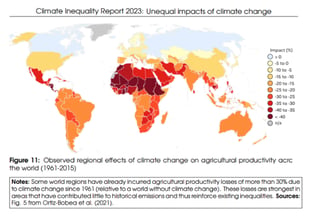
Speaking of crop yields, here’s a visualization from the 2023 Climate Inequality Report, of losses that have already occurred since the 1960s (the darker the red, the worse the yield compared to a counterfactual with no climate warming). In 1960 atmospheric CO₂ concentration was 317 parts per million (ppm), and today it’s 420 ppm). Already today, “extreme adverse effects have materialized in tropical and subtropical countries in Africa and Latin America, such as Mali, Niger, Sudan, Nicaragua, and Guatemala with productivity losses up to 40% due to anthropogenic climate change.” As agricultural scholars know “even a single day of heat stress might cause serious damage to the grain yield.”
Every one of the omitted, or not well-captured, physical and sociopolitical factors listed above can cause the actual trajectory of the climate crisis to deviate from predictions, perhaps wildly. One way to think of this is through the “butterfly effect”—where in a complex interconnected situation a tiny wing flap on one continent can trigger a tornado on another. As climate scientist Zeke Hausfather told the Washington Post, “we’re playing Russian roulette with the climate.” That trumpeted 2-to-3 degree non-doomsday temperature range that optimists love to focus on is far from a safe bet. “Higher temperatures are still possible if humans get unlucky with how the planet responds to higher CO2 levels,” he warns, referring to the “climate sensitivity” parameter, which could trigger butterfly-effect amplification. The same note of caution is sounded in the latest IPCC report but the relevant line is buried in footnote 49 on page 30: “Temperature levels > 4C can also occur from lower emission scenarios if climate sensitivity or carbon cycle feedbacks are higher than the best estimate.” (Thompson in Escape From Model Land introduces a new and potentially even more troubling phenomena dubbed the Hawkmoth effect: for those seeking the full nerd experience, an endnote of this article briefly describes this new kind of model deficiency and weighs its possible implications for the climate crisis.)2
Even a basic grasp on the long-known traits of complex systems and butterfly effects should have been enough to demand caution: small-seeming factors can’t be safely ignored based on intuitions about seeming insignificance. To imagine otherwise is to express ignorance of complex systems and their nonlinear dynamics, and to deny the long-known results of the earth-systems science of tipping points (which economic impact models known as Integrated Assessment Models or IAMs do in fact basically ignore—making them in a very direct sense, science denying).
It’s light-years beyond foolish to bet on cascading feedback and butterfly effects all landing favorably. We must act to aggressively minimize risks—especially of doom-delivering impacts on the planet’s poor. When economists (or other math-addled nerds) attempt intricate “optimal” policy tradeoffs, they’re admitting that they’re lost in model la-la-land.
Significant details of the degree of “fit” to recent earth-system measurements of our best models are not looking so rosy. Indeed, they’re thoroughly thorny—impacts on sea levels, the water cycle, humidity, and local temperature deviations are all arriving ahead of when models had predicted. Here’s a “burned ember” chart from the latest IPCC report, showing that impacts that we “thought would happen at 3°C … are now [expected to be] happening at ~1.5°C.” A 2021 report by the Australian National Centre for Climate Restoration put this issue this way:
“There is a consistent pattern in the IPCC and the research community of presenting detailed, quantified (numerical) modelling results, but then briefly noting more severe possibilities—such as feedbacks that the models do not account for—in a descriptive, non-quantified form. Sea-level rise, polar ice sheets and some carbon-cycle feedbacks are three examples. Because policymakers and the media are often drawn to headline numbers, this approach results in less attention being given to the most devastating, high-end, [and difficult-to-quantify outcomes].”
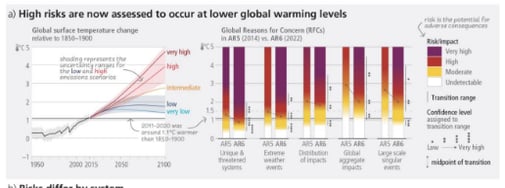
What the Australians describe here is a gourmet recipe for a banquet of elite ignorance-based optimism. We must be super clear about what current “optimistic” media preferences mean in terms of this specific risk: How likely are we to collectively mount a coherent and commensurate response to the multiple encircling crises when their foreseeable harms are de-emphasized in policy-shaping report summaries and filtered entirely out of upbeat media? One concrete illustration of our scientific uncertainties can be seen in a recent Washington Post article headlined “Scientists are baffled why oceans are warming so fast.”
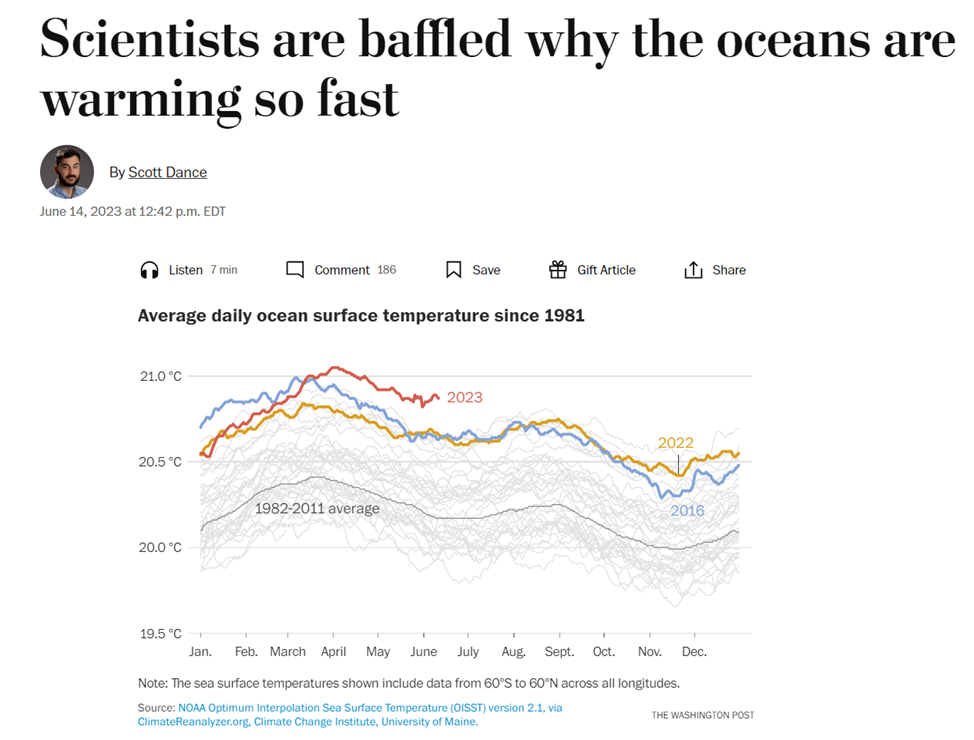
The article quotes Brian McNoldy, a hurricane researcher at the University of Miami saying “This is totally bonkers and people who look at this stuff routinely can’t believe their eyes.” He explains that “Digging into statistics a little, the global sea surface temperature anomaly on June 10 is 4.47 standard deviations above the mean. What does that mean in English? There’s a 1-in-256,000 chance of observing what we’re observing. This is beyond extraordinary.” The takeaway here is that the planet’s oceans aren’t behaving normally. And scientists don’t have a handle on why.
Here’s how climate scientist Kevin Anderson seeks to blow the whistle, in a British Royal Geographical Society blog post called the “IPCC’s conservative nature masks true scale of action needed to avert catastrophic climate change” He writes:
“for over two decades, the IPCC’s [modelling]… has undermined the necessary scale of emission reductions. In 2023, I can no longer tiptoe around the sensibilities of [modelers] overseeing this bias… they have been as damaging to the agenda of cutting emissions as Exxon was in misleading the public.”
Anderson means the hundreds of billions of tons of carbon capture that IPCC scenarios math-o-magically assumed (again, that’s known to be infeasible; absent mechanical miracles, which could perhaps be conjured up by devoted and passionate prayers of that elite-beloved religious cult known as techno-optimists).
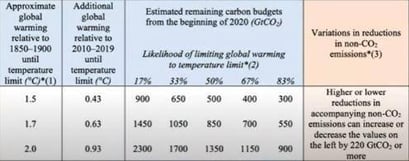
One handy red flag for risky climate punditry or journalism is how probabilities are handled. Consider the above table, which is typical of IPCC-model-informed analyses, and note the use of precision-implying probabilities: 17 percent, 33 percent, and 83 percent chances, etc. Climate journalists who repeat such figures without copious clarifying caveats are misleading their readers (perhaps out of credulousness, or ignorance). When journalists repeat IPCC language like “give the world a 66 percent chance” they risk leaving readers with a false impression. This kind of “carbon math” isn’t and can’t be so clearcut. Sufficiently skilled science journalists know (or should know) that those “chances” are properties of model-land objects; they’re not from, or really about, the real world. They’re definitely a different animal than everyday “odds”—they’re not remotely like rolling dice or Russian roulette, where stable causal processes lead to calculable future-relevant chances. Yet readers and leaders aren’t duly warned.
The truth is we’re in uncharted waters. We face an un-modellable future, with circling radical and unquantifiable uncertainties, menaced by close-at-hand tipping points. Atmospheric carbon concentrations have been higher, but that was millions of years ago, and our rates of carbon dumping are geologically unprecedented. Prior shifts of atmospheric CO₂ of the magnitude we’ve already caused in just the last couple of decades previously took many thousands of years to unfold, allowing time for ecosystem processes and species to coadapt. Some climate experts, like NASA’s Peter Kalmus and IPCC lead author Julia K. Steinberger, are taking commensurate crisis measures, e.g. by joining “Scientist Rebellion” protests and being arrested. Scientist Rebellion now has 1,200 scientists in 26 countries. But you’d be hard-pressed to find press coverage of that in optimism-biased courtier media.
The Worst Offenders: The Economists
We need to keep in mind the distinction between physical models of the effects of climate change and economic models (typically known as Integrated assessment models or IAMs). Even the basic outlook of dominant economists tends to clash violently with that of real scientists. As climate scientists issue dire warning after dire warning, here’s how economist and IPCC author Richard Tol minimized concerns in a recent macroeconomic literature review: “The impact of climate change on the economy and human welfare is likely to be limited … in the twenty-first century.” Proper scientists, on the other hand, such as Joeri Rogelj, director of research at the Grantham institute, Imperial College London, say things like:
“Science tells us that climate change risks increase rapidly between 1.5C and 2C of warming. Looking at the last years, during which we experienced some of the impacts of a 1.2C warmer world [such as heatwaves, flooding and extreme weather]—one would be hard pressed to call this safe.”
Or Tim Lenton, Chair in Climate Change and Earth System Science at the University of Exeter, who warns of: significant tipping points that could be triggered at 1.5 degrees Celsius of warming.” He concludes that this “growing threat of irreversible climate changes must compel political and economic action.” And let’s not neglect already-arriving and very much not “limited” impacts like the current “devastating drought in the Horn of Africa [which] would not have happened without the… the climate crisis.” It “has affected about 50 million people… directly and another 100 million in the wider area.” Perhaps what Tol means by “limited impact” is limited to poor nations (which needn’t trouble us in resource-blessed, comfortable, and optimistic countries).
Thompson decorously (and Britishly) describes this vast divergence between scientists and economists as a “discrepancy.” That almost nobody outside the warring academic fields knows about this gigantic globe-gambling dispute is due in part to poor judgment by climate editors who seem bent more on mood management than on responsible journalism. Why, one wonders, haven’t substantive and credible criticisms of IPCC models been judiciously reported on? For instance, Sir Nicholas Stern a decade ago wrote: “Many scientists are telling us that our models grossly underestimate the risks. In these circumstances, it is irresponsible to act as if the economic models currently dominating policy analysis represent a sensible central case.”
Or consider the warnings from a 2020 paper called “The failure of Integrated Assessment Models as a response to ‘climate emergency’: the Emperor has no clothes” by Salvi Asefi-Najafabady, Laura Villegas-Ortiz and Jamie Morgan. In it they write that IAMs by design “are limited in their capacity to incorporate complexities, nonlinearities, … [and] tipping points … [which are all known] typical features of climate change.” For instance, despite constantly being (mis)described as “policy-relevant,” these models simply ignore migration. IPCC scenarios with very different emissions levels and temperature increases use the same population distribution which Asefi-Najafabady characterizes as “obviously implausible.” Even at today’s 1.2 C rise, 22 million people annually are already displaced by climate effects. And that could mushroom into hundreds of millions before a baby blessed to be born today into an optimistic-elite-media informed family graduates from prep school (and within that eliteling’s lifetime, a billion people in equatorial nations may be forced to choose between migration and starvation). Perhaps more properly informed elite parents might be prepared to make much more climate effort (like curtailing their biosphere-burdening extravagances) to avoid leaving quite such a resource-war ravaged world for the pampered offspring they supposedly love to live in?
It is irredeemably irresponsible to sugarcoat all this lack of realism as constituting grounds for optimism. Every citizen should know that many utterly foreseeable (indeed, already arising) sociopolitical impacts just aren’t reflected “in” IPCC-approved models. As Asefi-Najafabady et al. rightly note, the “apparent rigor and technical complexity of [these economic impact models] convey a sense of authority that is unfounded.” These economic models can profoundly mislead policymakers and credulous media. And when weighing the reliability of economics nerds, don’t forget that their track record stinks. A highly critical paper on the financial crisis of 2008, cited by the Wharton Business School journal, blamed the economics “profession’s insistence on constructing models that, by design, disregard the key elements driving outcomes in real world markets.” They can’t model ordinary economies particularly well, let alone climate-crashed ones. Given such well-known shortcomings and shenanigans, it’s puzzling why supposedly data-savvy media defer to economists. As I’ve written elsewhere, whatever economists are up to, it isn’t remotely like real-science modeling, they’re often only crudely cosplaying as scientists.

Shockingly crude math models won William Nordhaus the 2018 Nobel-equivalent in economics. At the prize podium he presented their results as indicating that a 3.5C temperature rise by 2100 was economically “optimal” (slide 6). And since Nordhaus’s models have played a leading role in delaying action for decades, I’d nominate them for another prize: “the most harmful math object ever” created. Here’s a scientific review that specifically blames the IAM-induced delusions of economists for decades of delays in climate response. They will harm billions yet unborn for many generations.
To see why that language isn’t unduly harsh, consider Steve Keen’s paper “The appallingly bad neoclassical economics of climate change,” which describes glaring and gigantic flaws in Nordhaus’s 2-step method for assessing climate damages. First, Nordhaus simply asserts that economic activity that occurs indoors is not “exposed to climate change.” Here’s his sector table with 87% of GDP “negligibly affected” by climate change. But obviously this cat’s cradle of a crisis isn’t only about outdoor temperatures—it involves many complex entangled factors. For instance, flooding, which of course can harm all economic sectors, as it did earlier this year in the archetypal biblical deluge that inundated a third of Pakistan’s land area. Or conversely, droughts draining rivers (severing supply chains, as the Rhine and Mississippi did last year, or knocking out hydropower and nuclear plants, which need water for cooling). Ignoring such links is ludicrous. 
In the second stage, Nordhaus applies a “damage function” to that fraction of the economy he classifies as exposed. His damage function uses a very simple equation which seeks to relate reductions in GDP to just one variable, the increase in temperature. It requires only one coefficient which is math-o-magicked-up by “curve fitting” to data on how economic activity varies by temperature under today’s climate conditions. The crucial thing to note is that this sort of statistical curve fitting uses no scientific knowledge of any causal relationships at play. It just draws a line through the data points, and assumes that that line mathematically captures a useful description.
The quickest way to get the main issue across here is by using these fun xkcd cartoons:

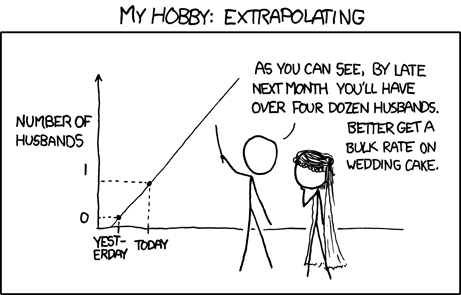
Each of the very different red lines can be “curve fitted” to the same array of data points. Without other scientific knowledge of the actual causal factors involved there’s no way to know which is most apt. And extrapolations (by curves or straight lines) without appropriate causal knowledge can lead to O’Neil’s “spectacularly stupid projections” (as it did in the covid case described above).
Now you might think prestigious nerds would need no reminder of those basics. But here’s the chart that Keen uses to recreate Nordhaus’s MIT-trained “thinking”: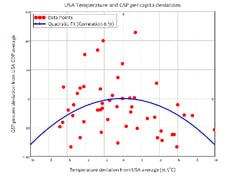
The blue line is “curve-fitted” (though, as you can see, quite poorly) to the red dots which plot economic activity on the vertical axis in various locations that have different average annual temperatures on the horizontal axis (in our current climate). But what reasoning justifies the belief that today’s statistical correlation of economic activity and temperature might be a good guide for a future of radically different conditions than prevail today? Foolery of this sort would fail in first year undergraduate physics. And it’s a lot like the infamous Trump White House COVID prophecy. For extrapolations from curve-fitting to work well, future conditions have to be very similar to those that generated the data that you have on hand—an enormously dumb assumption on climate (on a par with the bizarre idea that indoor activity is immune).
Imagine Nordhaus’s approach applied in 1923 to forecast today’s economy. Back then farms employed 30% of workers (now <10%) and the computer I’m writing this on wasn’t even imaginable. Does it make any logical sense that the millions of shifting causal interactions operating a century ago could in a useful way be captured in a single static parameter? Which could somehow usefully predict what’ll happen over a century? It is like using current bottled water sales trends to project water markets in a Mad-Max-Fury-Road world. Keen calls this extrapolation of today’s statistical correlation into a known-to-be-radically different future “the most unrealistic and dangerous ‘simplifying assumption’ in the history of economics.” Meanwhile, real scientists warn of tipping-points which risk pushing the biosphere into completely different and unknown dynamics at temperatures far lower than Nordhaus’s “optimal.” Yet he is still peddling the “usual absurdities” today. That’s how climate scientist Tim Garrett characterizes Nordhaus’s 2023 model (projects GDP “damages… to be around 3.12% of output at…3°C”).

Beyond the under-the-hood woes, much avoidable damage has been done here by lax language, and a mass failure of due diligence. Nordhaus initially used the term “optimal” in a technical sense and should never have done so publicly without major caveats. Sadly, he did frequently (including from the Nobel podium). Apparently almost none of his peer reviewers, or tribe-mates, or journalists seem to have caught this, or deemed it worthy of public attention. Nordhaus’s own caveats, buried in his model’s user guide, explicitly state that his optimal is “unrealistic [but] provides an efficiency benchmark.” (Another aside: economic efficiency is a fiendish trick word that harbors appalling pro-rich and anti-poor biases, using standard efficiency-seeking tools. As I explain here, it always looks “cheaper” and more “efficient” to harm the poor.) Nordhaus’s user manual also mentions many missing hard to model factors and uncertainty in “virtually all components from economic growth to damages.” He cosplay-scienced all this by adding a further fudge-factor of “25 percent of the monetized damages,” which he himself calls “a judgmental adjustment.” Has no Nobel staffer, or journalist, read the fine print? If more players had been duly diligent, this immense imaginary bean counting fiasco might not have delayed climate action for decades.
Fancier IAMs exist (here’s a good description), but they suffer similar realism-resisting issues, as well as contestable embedded value judgements (e.g. favoring “technological fixes or shifts in the sources of energy, over changes” in consumption, i.e. protecting rich-nation consumption). Thompson (the Model-Land escape artist) describes a climate model as a “mathematical version of climate fiction.” But, I’d argue that economic impact models (IAMs) are far less realistic than any actual fiction could afford to be without being laughed at. Thompson also corroborates Asefi-Najafabady’s damning assessment: the IPCC’s model collectively have “little focus … on cascading impacts” like “food and water crises, displacement of peoples, armed conflict and so on.” Perhaps it is no coincidence that these powerful policy-shaping math-masked fictions just happen to protect elite privileges and interests? Including those of rich-nation model-makers themselves?
Pause for a minute here. Had you assumed that the world’s leading effort to handle humanity’s greatest hurdle, involving numberless nerds of every tribe, had prudently accounted for wars, refugees, drought, famine, and justice? Well, they have not. We should be wary of every nerd, or analyst, or journalist who hasn’t obstreperously objected to, or outright blown the whistle on, the IPCC’s utterly unrealistic overly optimistic political-elite-comforting models. On the media front, the logical possibilities here seem to be either that the gatekeepers don’t know about this enormous litany of flaws and omissions, or that they do know and judge them unworthy of the attention of their audiences. Does either of those options enhance your confidence in their ability to guide us in the epic epoch-defining challenges confronting us?
The Upshot: Apocalypse For Thee, Not For Me
Climate change is not just going to be “apocalyptic,” it’s already apocalyptic. It’s just that the apocalypse is not something that happens to the entire world at once. Instead, the apocalyptic events are experienced mostly by the world’s poorest people (who, incidentally, have contributed the least to creating the problem). Who, witnessing the scale of flooding in Pakistan last year, could possibly say that the climate crisis is not “apocalyptic,” unless you regard Pakistanis as unpeople whose well-being simply doesn’t factor into the equation? 33 million people were displaced, and millions of homes destroyed.
When white Western elites publish books with titles like It’s Not The End of The World or Apocalypse Never or False Alarm, what they mean is “it’s not the end of the world for people like me,” “apocalyptic conditions will never be experienced by my sector of society,” and “those of us who are among the world’s richest do not need to be alarmed.” Of course, even these are false comforts—the mansions of Malibu are flammable, after all.
These cosetted climate-optimists seem to advocate treating the planet’s poor like non-player characters in rich-people YOLO games (the “you only live once” lifestyle of jet-setting jaunts that elite fomo-sapiens fear missing out on, like this New York Times guide to “36 hours in Tokyo”). We must not allow lost-in-model-la-la-land nerds and self-centered media elites shape humanity’s climate responses. As Andreas Malm, Swedish eco-philosopher and author of How to Blow Up a Pipeline, has astutely written: “If we let the dominant classes take care of this problem, they’re going to drive at top speed into absolute inferno.”
Is It “Doomerism” or Realism?
I’m not a climate optimist. Optimism assumes things will go well without acknowledging that all good outcomes are the product of determined action, not the inertia or minor tweaks of business-as-usual (we can’t Tesla our way out of this). As philosopher Susan Neiman reminds us, “hope is not optimism.” Too often “optimism is a refusal to face facts. Hope aims to change them. When the world is really in peril, optimism is obscene.” There’s an enormous amount we can do to make the climate situation much better, but that’s utterly conditional on how much of the hard work we do, and what sacrifices we make, to avoid worse outcomes.
But I’m also not a gloomy pessimist, and Neiman rightly warns that “if we succumb to the seduction of pessimism… the world is lost.” Instead, I am conditionally and confidently hopeful. And my main objection to many of the leading voices preaching climate optimism, especially techno-optimists, is that they often advocate a low-effort, costless, ”no sacrifice” approach (here’s Ezra Klein evangelizing a “genuinely awesome” future with ”visions of more,” first and foremost for his elite audience). Their position is no sacrifices from elites, which ensures maximum burdens for the poor. Here, the global COVID crisis offers a clear and chilling lesson: as soon as they feel safe (and optimistic) the global elite will happily put profit and their lifestyles above protecting the lives of the poor.
It needs no feat of fancy math or fine philosophical thinking to figure out that it is our moral duty to courageously focus on mitigating how the climate crisis will impact the planet’s poorest and most vulnerable. As I’ve written in these pages before, We Can’t Have Climate Justice Without Ending Computational Colonialism. Colonial legacies still dramatically distort global resource usage, and IPCC models make no attempt to change that. For instance, as I wrote, they project a “2050 where no developing region has even caught up to today’s rich-nation living standards, and sub-Saharans merit just 4.6 percent of the consumption per capita of North Americans ($2,700 vs. $58,600). That’s three decades in which 14 times more resources per capita are used to add to rich-nation comforts than go to mitigating severe sub-Saharan poverty. All model metrics have similar diabolically disproportionate resource-hog skews (e.g., a North American in 2050 gets 8 times the energy of a sub-Saharan).”
As researchers reported earlier this year, the climate crisis has already pushed around 600,000,000 people outside of the “human climate niche.” Roughly, that means experiencing a mean annual temperature over 29°C. In 1980 only 0.3 percent of humans suffered that. That’s risen to 9% today and it’s heading to around 25 percent by 2030. So within 7 years, around 2,000,000,000 people, mostly in the poorest places, will face heat-driven “well-being decline” (which kicks in at mean annual temperatures above 28°C). Keeping to the “Paris Agreement 1.5 °C target reduces hot exposure” to 5 percent of the population (that’s 1,700,000,000 fewer in the danger zone).
Outside of the human niche, well-being depends on energy usage, and there’s no credible plan for ensuring that enough energy gets to the planet’s poorest people (for instance, “3.5 billion lack reasonably reliable access to electricity” today, and even carbon-rapture fantasizing IPCC models project that in 2050 sub-Saharans will have access to one-eighth the energy per capita of North Americans). The sheer inability to survive increasing heat will add another pressure forcing huge numbers to migrate. As James Baldwin wisely wrote, “not everything that is faced can be changed, but nothing can be changed until it is faced.”
Climate optimism means not facing the formidable tasks ahead of us. We are all part of what Oxford University philosophy professor Henry Shue calls the “pivotal generation,” having been born into a moment in history when we have an obligation to tackle this formidable crisis. It’s unconscionable to be optimistic, if that means feeling positive while rejecting any climate responses that aren’t costless or painless for the world’s resource-blessed elites. Imagine if the “greatest generation” had responded to World War II using the “feel-good-options-only” politics of the global elite.
Update: One sentence in this piece has been updated to make clear that for some factors, the author is critiquing their complete absence from IPCC models, whereas for others, the author is critiquing the way the models handle the factors.
I say typically, because that’s not true in poor nations, on which the global greedocracy imposes ruinously higher costs of capital, further adding to energy transition barriers. For instance, “the cost of capital of a privately funded renewable energy project in the rich country would have been close to 4%, and in the developing nation, 15%.” ↩
Even Nerdier Model Complexities: Butterfly and Hawkmoth Effects Most nerds will have heard of butterfly effects. Fortunately their impact can to some degree be managed in math model land; you simply rerun your models many times with a sensible span of parameter values. This yields a range of results that has a good chance of spanning the real outcome, and sensible statistics about risks of different outcomes. However, now there’s a new flap in town that isn’t so mathematically amenable. Erica Thompson’s book, Escape From Model Land, aims to popularize a more pernicious phenomenon that she dubs the “hawkmoth effect” (she coined that term in her PhD to reflect that these new bedeviling bugs are well camouflaged, and less photogenic than butterflies, so typically garner much less attention). This newly theorized effect arises not from problems with the precision of parameter values but from deficiencies in the very structures of math models (meaning flaws and omissions in the equations/algorithms, and how they’re combined). The upshot of these structural inadequacies is that your simulations can generate wild deviations from the reality they seek to simulate. Here’s Thompson’s explanatory diagram. In butterfly scenarios you can get close to the real outcome, the X in the top right, where the shaded area represents the range of model runs with sensible ranges of parameters. But with harder-to-pin-down hawkmoth effects, that’s less assured—your model output can end up in the lower right, nowhere near the real values. Outside of relatively simple scenarios, we never really have what Thompson calls a “perfect model.” Crucially she notes, your equations can be very close to being correct but they can still misbehave enough to beget bonkers results. Sadly, hawkmoth effects can’t be mathematically tamed, or even coherently quantified—they’re not well characterized by the statistics of running many models nor by misleadingly-precise-looking probabilities.

And of course, the climate crisis has many gnarly entangled mathematically-misbehaving moving parts. And it is plagued by flocks of butterfly and hawkmoth issues. Every one of the physical and sociopolitical factors listed above that aren’t well-addressed in climate models could generate hawkmoth impacts that wildly deviate from modeled trajectories.
The general lessons of these sorts of structural deficiencies in complex models, and what they mean for climate, are being actively thrashed out by dueling researchers, e.g., in the European Journal for Philosophy of Science: “An antidote for hawkmoths: on the prevalence of structural chaos in non-linear modeling” (2019), is parried by “An ineffective antidote for hawkmoths” (2022). While the details are beyond our scope here, it seems clear that given the risks arising from too little response to the climate crisis, we have sound warrant to justify erring on the side of caution. If policy judgements made based on IPCC models turn out to have been too optimistic, (for which there’s ample evidence provided above) there’s no do-over. The damage will have been done. And billions of the planet’s poor will pay the price in having to face worse lives. Decisions about this can’t be left to climate nerds who have been willing to use carbon capture trickery to keep us in the dark for decades. ↩




